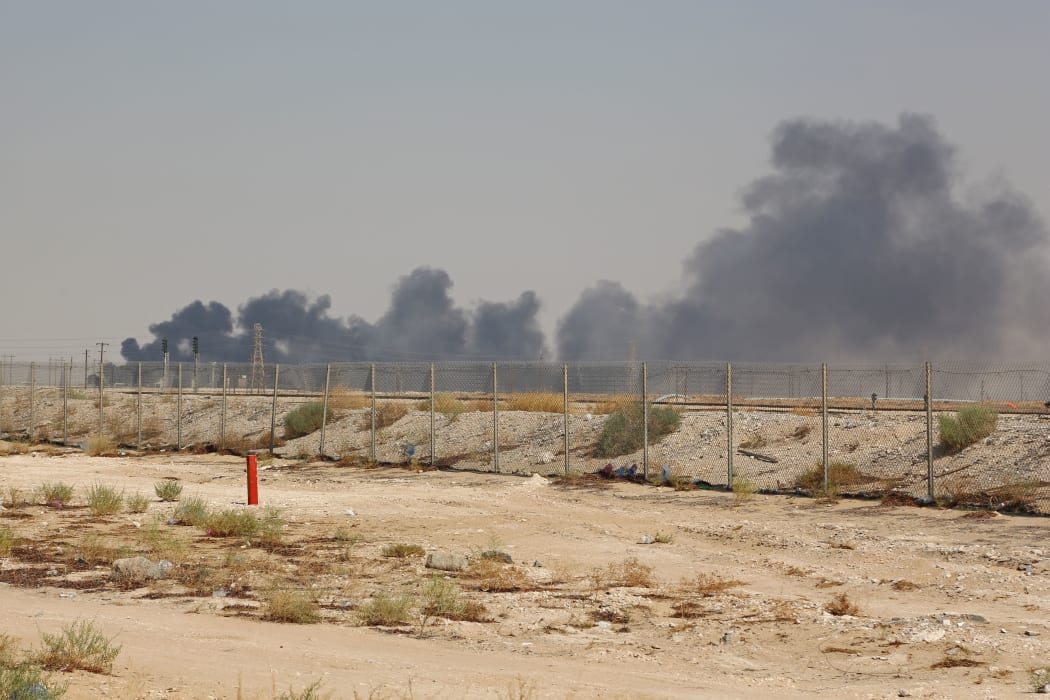Saudi Arabia has cut oil and gas production following drone attacks on two major oil facilities run by state-owned company Aramco.

Smoke billows from an Aramco oil facility in Abqaiq about 60km southwest of Dhahran in Saudi Arabia's eastern province on September 14, 2019. Photo: AFP
Energy Minister Prince Abdulaziz bin Salman said the strikes had reduced crude oil production by 5.7m barrels a day - about half the kingdom's output.
A Yemeni Houthi rebel spokesman said it had deployed 10 drones in the attacks.
US Secretary of State Mike Pompeo blamed the attacks on Iran saying there was no evidence they came from Yemen.
The Saudis lead a Western-backed military coalition supporting Yemen's government, while Iran backs the Houthi rebels.
In a statement carried by the Saudi Press Agency (SPA), Prince Abdulaziz said the attacks "resulted in a temporary suspension of production at Abqaiq and Khurais plants".
He said that part of the reduction would be compensated for by drawing on Aramco's oil stocks.
The situation was under control at both facilities, Aramco CEO Amin Nasser said, adding that no casualties had been reported in the attacks.
In a tweet, Mike Pompeo described the attack as "an unprecedented attack on the world's energy supply".
Tehran is behind nearly 100 attacks on Saudi Arabia while Rouhani and Zarif pretend to engage in diplomacy. Amid all the calls for de-escalation, Iran has now launched an unprecedented attack on the world’s energy supply. There is no evidence the attacks came from Yemen.
— Secretary Pompeo (@SecPompeo) September 14, 2019
"We call on all nations to publicly and unequivocally condemn Iran's attacks," Mr Pompeo added.
The US would work with its allies to ensure energy markets remain well supplied and "Iran is held accountable for its aggression", he added.
Tensions between the US and Iran have escalated since Mr Trump abandoned a deal limiting Iran's nuclear activities last year and reinstated sanctions.
The Houthi spokesman, Yahya Sarea, told al-Masirah TV, which is owned by the Houthi movement and is based in Beirut, that further attacks could be expected in the future.
He said Saturday's attack was one of the biggest operations the Houthi forces had undertaken inside Saudi Arabia and was carried out in "co-operation with the honourable people inside the kingdom".
TV footage showed a huge blaze at Abqaiq, site of Aramco's largest oil processing plant, while a second drone attack started fires in the Khurais oilfield.
"At 04:00 (local time) the industrial security teams of Aramco started dealing with fires at two of its facilities in Abqaiq and Khurais as a result of... drones," the official Saudi Press Agency (SPA) reported.
"The two fires have been controlled."
Later, the SPA reported that Saudi Crown Prince Mohammed bin Salman had told US President Donald Trump in a telephone conversation that the kingdom was "willing and able to confront and deal with this terrorist aggression".
The White House said Mr Trump had offered US support to help Saudi Arabia defend itself.
United Nations envoy Martin Griffiths described the attacks as "extremely worrying" in a statement in which he called on all parties in the Yemen conflict to exercise restraint.
Abqaiq is about 60km (37 miles) south-west of Dhahran in Saudi Arabia's Eastern Province, while Khurais, some 200km further south-west, has the country's second largest oilfield.
Saudi security forces foiled an attempt by al-Qaeda to attack the Abqaiq facility with suicide bombers in 2006.
Who are the Houthis?
The Iran-aligned Houthi rebel movement has been fighting the Yemeni government and a Saudi-led coalition.
Yemen has been at war since 2015, when President Abdrabbuh Mansour Hadi was forced to flee the capital Sanaa by the Houthis. Saudi Arabia backs President Hadi, and has led a coalition of regional countries against the rebels.
The coalition launches air strikes almost every day, while the Houthis often fire missiles into Saudi Arabia.
Mr Sarea, the Houthi group's military spokesman, told al-Masirah that operations against Saudi targets would "only grow wider and will be more painful than before, so long as their aggression and blockade continues".
Houthi fighters were blamed for drone attacks on the Shaybah natural gas liquefaction facility last month, and on other oil facilities in May.
There have been other sources of tension in the region, often stemming from the rivalry between Saudi Arabia and Iran.
Saudi Arabia and the US both blamed Iran for attacks in the Gulf on two oil tankers in June and July, allegations Tehran denied.
In May four tankers, two of them Saudi-flagged, were damaged by explosions within the UAE's territorial waters in the Gulf of Oman.
Tension in the vital shipping lanes worsened when Iran shot down a US surveillance drone over the Strait of Hormuz in June, leading a month later to the Pentagon announcing the deployment of US troops to Saudi Arabia.
- BBC

